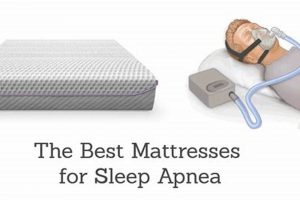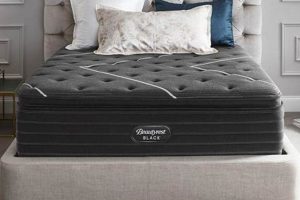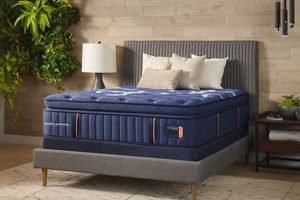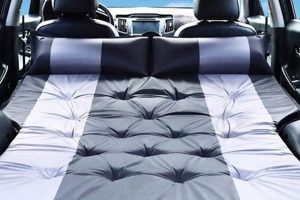The optimal sleeping surface for individuals at risk of developing decubitus ulcers, commonly known as pressure sores, aims to minimize sustained pressure on bony prominences. These specialized mattresses redistribute weight, thereby reducing the likelihood of tissue damage caused by prolonged compression. Examples include alternating pressure air mattresses, foam mattresses with convoluted surfaces, and gel-infused mattresses designed for enhanced weight distribution and temperature regulation.
Selecting an appropriate sleeping surface is critical for pressure ulcer prevention and management. These medical devices improve circulation to vulnerable areas, promoting skin health and reducing patient discomfort. Historically, simple measures like frequent repositioning were the primary means of prevention. Advances in materials science and engineering have led to the development of sophisticated mattress technologies that significantly improve patient outcomes and reduce healthcare costs associated with treating advanced pressure sores.
The subsequent sections will delve into the specific types of mattresses used in pressure sore prevention, examine their features and benefits, and provide guidance on selecting the most suitable option based on individual patient needs and risk factors. Material composition, design features, and maintenance requirements will also be discussed.
Key Considerations for Selecting a Pressure Sore Prevention Mattress
The effective selection and use of a supportive sleeping surface are crucial components of a comprehensive pressure ulcer prevention strategy. The following considerations should guide the decision-making process.
Tip 1: Evaluate Individual Risk Factors: A thorough assessment of the patient’s risk factors, including mobility, nutritional status, and existing medical conditions, is paramount. Higher-risk individuals may necessitate more advanced mattress features.
Tip 2: Prioritize Pressure Redistribution: The primary function of the mattress is to redistribute pressure away from bony prominences. Look for mattresses with features such as segmented air chambers or gel-infused foam that effectively offload pressure.
Tip 3: Consider Microclimate Control: Maintaining a dry and cool skin surface minimizes the risk of skin maceration and breakdown. Mattresses with breathable covers or integrated air circulation systems contribute to effective microclimate management.
Tip 4: Assess Cleanability and Durability: Infection control is a critical consideration. The mattress should be easily cleaned and disinfected, and the materials should be durable enough to withstand repeated cleaning without degradation.
Tip 5: Evaluate Mattress Height and Compatibility: Ensure that the mattress height is compatible with the bed frame and that it does not compromise the patient’s ability to transfer safely. Consider whether the mattress is compatible with existing bed controls or features.
Tip 6: Consult Healthcare Professionals: Guidance from healthcare professionals, including nurses and physical therapists, is crucial. They can assess individual needs and recommend the most appropriate mattress type.
These guidelines provide a foundation for informed decision-making, ultimately leading to enhanced patient comfort and a reduced risk of pressure ulcer development.
The following sections will cover mattress types, maintenance, and financial considerations.
1. Pressure Redistribution
Pressure redistribution is a fundamental characteristic of any mattress designed to prevent or manage pressure sores. The sustained concentration of pressure on bony prominencessuch as the sacrum, heels, and hipsimpedes blood flow to the affected tissues. This ischemia, if prolonged, leads to tissue damage and the formation of pressure ulcers. Mattresses that effectively redistribute pressure minimize these concentrated forces, promoting adequate circulation and preventing tissue breakdown.
The effectiveness of pressure redistribution can be illustrated by comparing traditional mattresses to specialized medical mattresses. Traditional mattresses often conform poorly to the body’s contours, resulting in high-pressure points. In contrast, mattresses designed for pressure sore prevention employ various techniques, such as alternating air cells, gel infusions, or multi-layered foam constructions, to distribute the body’s weight more evenly across the support surface. A practical example is the alternating pressure air mattress, which cyclically inflates and deflates individual air cells, constantly shifting the pressure points and ensuring that no single area sustains prolonged compression. Similarly, gel-infused mattresses conform to the body’s shape, distributing weight and reducing peak pressures.
Understanding the connection between pressure redistribution and mattress design is crucial for selecting the most appropriate support surface. Failure to adequately address pressure redistribution can lead to the development or worsening of pressure sores, increasing patient morbidity, healthcare costs, and care burden. Therefore, healthcare providers and caregivers must prioritize mattresses that demonstrably reduce pressure concentration and promote optimal tissue perfusion. Selecting the ideal mattress is not only a decision about comfort but a proactive measure against a serious and costly medical condition.
2. Microclimate Control
Microclimate control is a critical factor in the selection of mattresses intended for pressure sore prevention. The microclimate, defined as the temperature and humidity at the interface between the skin and the support surface, directly impacts skin integrity. An elevated temperature and humidity level can weaken the skin’s barrier function, increasing the risk of maceration and subsequent breakdown.
- Moisture Management
Excessive moisture, stemming from perspiration, incontinence, or wound drainage, compromises the skin’s resilience and increases susceptibility to friction and shear forces. Mattresses designed for microclimate control incorporate materials with enhanced moisture-wicking capabilities, facilitating the evaporation of moisture and maintaining a drier skin surface. Examples include fabrics with open-weave structures or specialized fibers that promote airflow and absorb moisture.
- Temperature Regulation
Elevated skin temperature increases metabolic activity and oxygen demand, exacerbating the risk of ischemic damage in pressure-prone areas. Microclimate control mattresses utilize materials with inherent cooling properties or incorporate ventilation systems to dissipate heat and maintain a stable skin temperature. Gel-infused foams, for instance, possess thermal conductivity, allowing them to absorb and dissipate heat away from the body. Some mattr
esses employ integrated airflow systems to circulate air and further reduce temperature. - Material Breathability
The breathability of the mattress cover and internal components is paramount for effective microclimate control. Breathable materials allow for the exchange of air and moisture vapor between the skin and the environment, preventing the accumulation of humidity and maintaining a cooler, drier microclimate. Materials such as polyurethane films or cotton blends can offer varying degrees of breathability, influencing the overall effectiveness of microclimate management.
- Impact on Skin Integrity
Effective microclimate control directly contributes to the maintenance of skin integrity by reducing the risk of maceration, minimizing friction and shear forces, and optimizing skin temperature. Mattresses that effectively manage the microclimate create a more favorable environment for skin health, decreasing the likelihood of pressure sore development. The absence of adequate microclimate control mechanisms can negate the benefits of pressure redistribution, highlighting the interconnectedness of these factors.
The successful implementation of microclimate control in mattress design is essential for pressure sore prevention and management. Mattresses lacking these features may inadvertently contribute to skin breakdown, even when pressure redistribution capabilities are present. Therefore, microclimate control should be a primary consideration in the selection of appropriate mattresses for individuals at risk.
3. Shear Reduction
Shear force, a tangential force acting parallel to the skin surface, significantly contributes to the development of pressure sores. Mattresses designed to mitigate shear play a critical role in protecting vulnerable tissue and are an essential consideration in selecting a supportive surface.
- Friction and Interface Pressure:
Shear is exacerbated by friction between the skin and the mattress surface. High interface pressures, resulting from inadequate pressure redistribution, intensify the effects of shear. Mattresses that minimize friction through smooth, low-resistance surfaces, coupled with effective pressure redistribution, reduce the risk of shear-induced tissue damage. Example: A patient sliding down a bed generates shear force; a low-friction mattress surface reduces the strain on the skin.
- Material Selection and Surface Properties:
The materials used in mattress construction directly influence shear forces. Surfaces with a high coefficient of friction, such as tightly woven fabrics, resist movement and increase shear. Conversely, materials like silicone-coated fabrics or specialized low-friction textiles minimize resistance, allowing the skin to glide more easily. This reduces the tangential forces transmitted to underlying tissues. Example: A mattress cover made of breathable, low-friction material will allow for easier repositioning, reducing shear.
- Mattress Design and Articulation:
Mattresses designed to articulate with adjustable beds must accommodate changes in body position without generating excessive shear. Segmented mattress designs or mattresses with flexible zones allow the surface to conform to the body’s contours, minimizing shear during bed adjustments. Example: An adjustable bed with a mattress that doesn’t flex properly can create significant shear forces when the head of the bed is raised.
- Impact on Deep Tissue Injury:
Shear forces are implicated in the development of deep tissue injuries (DTI), which are often difficult to detect and treat. Shear can cause damage to muscle and subcutaneous tissue without visible signs of skin breakdown, leading to DTI. Mattresses that effectively reduce shear minimize the risk of these insidious injuries. Example: An individual with limited mobility is at high risk of DTI due to sustained pressure and shear; a mattress designed to reduce both is critical.
The integration of shear reduction strategies into mattress design is paramount for effective pressure sore prevention. Failure to address shear forces can compromise the benefits of pressure redistribution and microclimate control, increasing the risk of tissue damage. Therefore, evaluating a mattress’s ability to minimize shear is essential when selecting a surface for individuals at risk of pressure sores.
4. Weight Capacity
Weight capacity is a crucial parameter when selecting a mattress for pressure sore prevention. A mattress exceeding its stated weight limit compromises its ability to effectively redistribute pressure, negating the intended therapeutic benefits and potentially exacerbating the risk of tissue damage. This direct relationship underscores the importance of considering an individual’s weight when choosing a supportive surface. For instance, a mattress designed for individuals weighing up to 250 pounds will not provide adequate pressure relief for a 300-pound individual, regardless of its other features, such as advanced foam technology or alternating pressure capabilities. The concentrated pressure on bony prominences increases dramatically, counteracting the very purpose of a specialized pressure sore prevention mattress.
The selection of a mattress with an appropriate weight capacity also affects its long-term durability and performance. Overloading a mattress can lead to premature wear and tear, causing the support structure to degrade and compromising its ability to maintain proper pressure redistribution. This degradation can manifest as sagging, uneven support, or failure of internal components, such as air cells or foam layers. In practical terms, this means that a mattress intended to last several years may need to be replaced much sooner, incurring additional costs and potentially exposing the patient to increased risk of pressure sore development due to the diminished support.
In summary, adequate weight capacity is not merely a technical specification but a fundamental requirement for a pressure sore prevention mattress to function as intended. Selecting a mattress that accommodates the individual’s weight ensures optimal pressure redistribution, prolongs the mattress’s lifespan, and contributes to a more effective and cost-efficient pressure ulcer prevention strategy. Healthcare providers and caregivers must prioritize this consideration to safeguard patient well-being and maximize the therapeutic benefits of specialized support surfaces.
5. Cleanability
The connection between cleanability and the characteristics of an ideal mattress for pressure sore prevention is paramount due to the elevated risk of infection and contamination in individuals susceptible to these ulcers. Pressure sores often compromise the skin’s integrity, creating an entry point for pathogens. Consequently, a mattress’s ability to be thoroughly and effectively cleaned is not merely a matter of hygiene but a critical factor in preventing secondary infections that can significantly impede healing and exacerbate patient morbidity. The ideal mattress should incorporate materials and design features that facilitate easy cleaning and disinfection, minimizing the r
isk of cross-contamination.
The practical significance of cleanability becomes evident in healthcare settings, where multiple patients may use the same mattress over time. Inadequate cleaning protocols can lead to the transmission of infectious agents, such as Clostridium difficile or methicillin-resistant Staphylococcus aureus (MRSA). For instance, a mattress with intricate seams or absorbent materials may harbor bacteria even after standard cleaning procedures. Mattresses with waterproof, wipeable surfaces and removable covers that can withstand repeated laundering offer a superior level of infection control. Regular and thorough cleaning, using appropriate disinfectants, is essential to maintain a hygienic environment and prevent the spread of infection. The choice of cleaning agents and their compatibility with the mattress materials must also be carefully considered to avoid damage or degradation that could compromise the mattress’s integrity and cleanability over time.
In conclusion, cleanability is an indispensable attribute of an optimal mattress for pressure sore prevention. It directly influences the risk of infection, the ease of maintenance, and the overall longevity of the support surface. Prioritizing mattresses with superior cleanability characteristics is a proactive measure that contributes to enhanced patient safety, reduced healthcare costs associated with infection control, and improved clinical outcomes in the management of pressure sores.
6. Durability
Durability is inextricably linked to the selection of an optimal mattress for pressure sore prevention. A mattress designed for this purpose must withstand prolonged and repeated use, often under demanding conditions, to consistently deliver its intended therapeutic benefits. Premature degradation of the mattress material or support structure compromises its ability to redistribute pressure effectively, regulate microclimate, and minimize shear forces. This, in turn, diminishes its protective function and increases the risk of pressure sore development or exacerbation. The financial implications associated with frequent mattress replacement due to inadequate durability are significant, as is the potential for diminished patient comfort and compromised care during the periods of inadequate support.
The correlation between durability and cost-effectiveness is also noteworthy. While a lower-priced mattress may seem appealing initially, its longevity is a critical factor in determining its true value. A more durable mattress, even with a higher upfront cost, can prove more economical over time by reducing the frequency of replacements. Furthermore, a durable mattress is more likely to maintain its integrity and performance throughout its lifespan, ensuring consistent pressure relief and minimizing the need for additional support measures, such as specialized cushions or overlays. Conversely, a mattress that quickly loses its shape, firmness, or functionality due to poor durability poses a recurring expense and potentially compromises patient well-being.
In conclusion, durability is not simply a desirable feature but an essential attribute of an effective mattress for pressure sore prevention. It directly impacts the mattress’s performance, longevity, and cost-effectiveness, as well as the patient’s comfort and safety. Careful consideration of the mattress’s construction, materials, and warranty is therefore crucial when making a selection. Investing in a durable, high-quality mattress is a proactive step towards minimizing the risk of pressure sores and ensuring sustained patient comfort and care.
7. Patient Comfort
Patient comfort, while seemingly subjective, is a critical objective factor in the selection and effective utilization of mattresses designed for pressure sore prevention. A mattress that fails to provide adequate comfort can undermine patient compliance with prescribed care plans, leading to increased agitation, reduced sleep quality, and ultimately, a higher risk of pressure sore development. Comfort is not merely a luxury; it is an integral component of a comprehensive strategy for managing pressure ulcer risk.
- Pain Management and Pressure Redistribution
Effective pressure redistribution, while primarily aimed at preventing tissue ischemia, directly influences patient comfort. Mattresses that successfully offload pressure from bony prominences reduce localized pain and discomfort. The subjective experience of pain can significantly impact a patient’s willingness to remain in a therapeutic position, thus compromising the effectiveness of the mattress. A mattress that causes pain, even if it offers superior pressure redistribution on paper, may be less effective in practice than a more comfortable alternative.
- Thermal Regulation and Skin Sensitivity
Mattress materials and design features that promote thermal regulation contribute significantly to patient comfort. Excessive heat and humidity can lead to skin irritation and discomfort, increasing sensitivity and potentially predisposing the skin to breakdown. Mattresses with breathable covers and cooling technologies help maintain a stable and comfortable skin temperature, reducing the likelihood of these adverse effects. Patients with compromised skin integrity are often particularly sensitive to temperature fluctuations, making thermal regulation a crucial aspect of comfort.
- Shear Reduction and Movement Facilitation
Mattresses that minimize shear forces not only protect the skin but also enhance patient comfort by facilitating movement and reducing friction. A mattress that allows for easy repositioning and movement within the bed minimizes the effort required from the patient, reducing pain and fatigue. This is particularly important for individuals with limited mobility or pain conditions that make movement difficult. A smoother, more responsive mattress surface promotes comfort and independence.
- Psychological Well-being and Compliance
Patient comfort extends beyond physical sensations to encompass psychological well-being. A comfortable mattress promotes relaxation, reduces anxiety, and improves sleep quality, all of which contribute to a more positive patient experience. When patients are comfortable and feel supported, they are more likely to comply with prescribed care plans, including repositioning schedules and other preventive measures. A mattress that prioritizes comfort can therefore have a significant impact on patient outcomes.
In conclusion, patient comfort is not a secondary consideration but an essential element in the selection of a mattress for pressure sore prevention. It directly impacts pain management, thermal regulation, shear reduction, and psychological well-being, all of which contribute to patient compliance and overall effectiveness of pressure ulcer prevention strategies. A mattress that is both therapeutically effective and comfortable is more likely to promote positive outcomes and enhance the quality of life for individuals at risk of pressure sores.
Frequently Asked Questions
This section addresses common inquiries concerning mattresses designed for pressure sore prevention, providing concise and authoritative answers based on established medical knowledge.
Question 1: What types of mattresses are most effective for preventing pressure sores?
Mattresses designed for pre
ssure redistribution are most effective. These include alternating pressure air mattresses, foam mattresses with convoluted surfaces, and gel-infused mattresses. The selection depends on individual risk factors and care needs.
Question 2: How does an alternating pressure air mattress work to prevent pressure sores?
Alternating pressure air mattresses consist of interconnected air cells that cyclically inflate and deflate. This constant shifting of pressure points prevents prolonged compression of tissues, promoting circulation and reducing the risk of pressure sore formation.
Question 3: What role does mattress material play in pressure sore prevention?
Mattress material directly impacts pressure redistribution, microclimate control, and shear reduction. Materials such as memory foam, gel-infused foam, and low-friction fabrics contribute to these essential functions.
Question 4: How often should a pressure sore prevention mattress be cleaned, and what cleaning agents are recommended?
Pressure sore prevention mattresses should be cleaned regularly, typically after each patient use and whenever visibly soiled. Recommended cleaning agents include mild detergents and hospital-grade disinfectants, ensuring compatibility with the mattress material.
Question 5: Does the mattress cover impact the effectiveness of a pressure sore prevention mattress?
Yes, the mattress cover plays a significant role. It should be waterproof, breathable, and low-friction to protect the mattress core, manage microclimate, and minimize shear forces.
Question 6: How does weight capacity influence the choice of a pressure sore prevention mattress?
Weight capacity must be carefully considered. Exceeding the stated weight limit compromises the mattress’s ability to redistribute pressure effectively, potentially increasing the risk of pressure sore development.
The information provided in this FAQ section serves as a starting point for informed decision-making. Healthcare professionals should be consulted for individualized recommendations.
The following sections will delve into maintenance guidelines, cost considerations, and emerging technologies related to pressure sore prevention mattresses.
Conclusion
The preceding discussion underscores the importance of selecting a clinically appropriate sleeping surface for individuals at risk of developing pressure sores. The optimal mattress effectively redistributes pressure, manages microclimate, reduces shear forces, accommodates weight requirements, facilitates cleaning, exhibits durability, and promotes patient comfort. A comprehensive understanding of these factors is paramount for informed decision-making.
Prioritizing proactive prevention strategies, including the implementation of evidence-based mattress selection protocols, remains critical in minimizing the incidence of pressure sores and optimizing patient outcomes. Continued research and technological advancements will undoubtedly yield further refinements in mattress design and functionality, enhancing the effectiveness of pressure ulcer prevention efforts. Further investigation and clinical consultation are strongly encouraged to determine the most suitable product for individual patient needs.




![Top-Rated Best Daybed Mattress [2024]: Buyer's Guide Organic & Natural Mattress Buyer’s Guide: Non-Toxic Sleep Solutions Top-Rated Best Daybed Mattress [2024]: Buyer's Guide | Organic & Natural Mattress Buyer’s Guide: Non-Toxic Sleep Solutions](https://mattressworldpa.com/wp-content/uploads/2025/07/th-7669-300x200.jpg)


